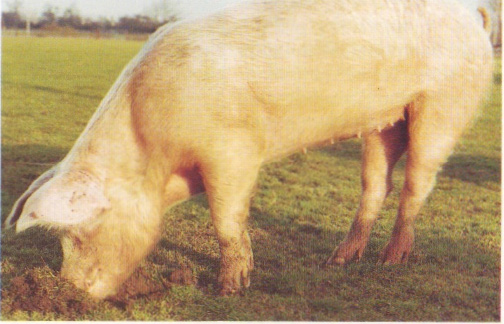TODAY'S FARM ANIMALS
THE INSIDE STORY
Page d
PIGS
 |
| Pig rooting happily at Hillside Animal Sanctuary. Photo: HAS |
STALLS AND TETHERS
From 1999, new legislation means that the horrific practice of keeping sows in narrow stalls, sometimes tied round the neck, will be illegal in the UK. In the year 2004/5 a ban on tethers only will come into force throughout the EU. (Tethers are a type of collar, or chain, to keep the pig from escaping from an open-ended stall. Often, these restraining devices eat into the sow's flesh, causing acute misery.) With the UK stalls and tethers ban in force, it's likely that other EU countries will move towards non-stall and tether systems, because of public concern.
FARROWING CRATES
These are metal-barred crates, into which sows are put shortly before they're due to give birth. At this time the mother pig's instinct is to gather twigs and straw for nest-building. The stress imposed on her, by imprisoning her at this important time in her life, is enormous. The excuse given for the practice of confining pregnant sows in crates (sometimes called pens) is that the mother is prevented from overlying her piglets, and perhaps smothering some. However, many farmers allow their pigs to farrow in a straw-filled area, with no increased losses. Selective breeding for size rather than maternal skills has contributed to problems associated with piglet mortality.
REPEATED PREGNANCIES
To maximise profits, most piglets are weaned at around three weeks of age (instead of the natural 3-4 months) and the sow mated again. On the factory farm, the breeding sow's life is an exhausting round of repeated pregnancies, with regular incarceration in the farrowing crate.
TAIL DOCKING
Many farmers remove at least half of the piglets' tails, using pliers or a hot docking iron. This mutilation is intended to prevent pigs chewing each others' tails. Clearly, they resort to this unnatural behaviour because they're frustrated, stressed and bored. The European Commission's Scientific Veterinary Committee has stated: "The problems of injury following tail biting should be solved by improved management rather than by tail-docking".
The same Committee concluded in its 1997 Report on pig welfare that tail docking is painful at the time of the operation and in some cases lead to "prolonged pain".
TRANSPORT AND SLAUGHTER
Pigs suffer from travel sickness, and journeys to slaughter can cause great stress. They have a very limited ability to sweat, so heat stress is common, both on the farm and in lorries carrying them to slaughter.
Pigs are stunned electrically, or rendered unconscious by carbon dioxide gas. They are then bled to death, via severed blood vessels in the chest. Scientists have demonstrated that pigs can regain consciousness, as they hang suspended by one leg on the slaughter line.
In 1997 alone, 312,663 live pigs were exported from the UK, many to suffer under the abysmally low standards often found in foreign abattoirs.